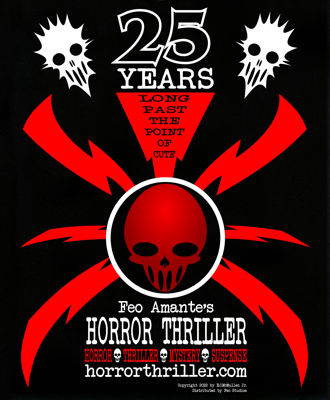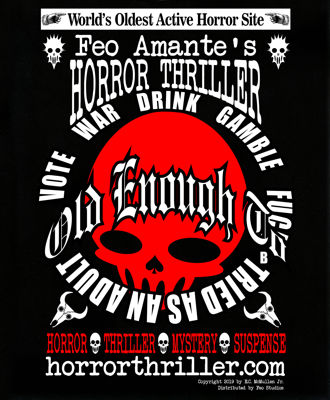 |
 |
Review by E.C. McMullen Jr. |
|
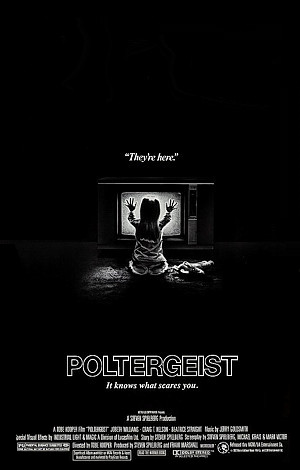
POLTERGEIST- 1982USA Release: June 4, 1982 Metro-Goldwyn-Mayer (MGM) / SLM Production Group Rated: Argentina, Iceland, Netherlands, Norway, West Germany: 16 / Australia: M / Brazil, Chile: 14 / Canada: A / Finland: K-16 / France: -16 / Italy: VM14 / Portugal: M/16 / South Korea: 12 / UK, Sweden: 15 / Singapore, USA: PG |
|||
Some of you may not know that though director Tobe Hooper (THE TEXAS CHAINSAW MASSACRE, EATEN ALIVE, SALEM'S LOT, THE FUNHOUSE, LIFEFORCE, INVADERS FROM MARS, THE TEXAS CHAINSAW MASSACRE 2, NIGHT TERRORS, THE MANGLER, CROCODILE, THE TOOLBOX MURDERERS, MORTUARY, Masters of Horror: THE DAMNED THING, Masters of Horror: DANCE OF THE DEAD) was credited for directing POLTERGEIST, there's been a long time mystery over whether that is true.
Some of the actors and crew involved went on record as saying they hardly ever saw Tobe on set and Steven Spielberg really directed POLTERGEIST. This makes sense because there is nothing about POLTERGEIST that looks like anything Tobe did before or since. Everything about this movie has Spielberg's foot and fingerprints all over every frame, every dolly, every edit, every cue of the emotional string pulling soundtrack.1
So for this review, I'm just going to talk as if Spielberg (JAWS, JURASSIC PARK, THE LOST WORLD, MINORITY REPORT, WAR OF THE WORLDS) did it, because he wrote it, produced it, and was on the set directing or co-directing with Tobe Hooper practically the whole time. He supervised the visual effects for it, which were produced at ILM under the supervision of Richard Edlund (FRIGHT NIGHT, BIG TROUBLE IN LITTLE CHINA, ALIEN³, SPECIES) and Dennis Muren (TERMINATOR 2, JURASSIC PARK, THE LOST WORLD, HULK, WAR OF THE WORLDS) who answered to Steven. Steven took full control of Post; was responsible as well for the audio editing of the film, the final sound mixes and loops, and the selection of Jerry Goldsmith as the composer of the score.2
1 2 3 Before you dismiss this out of hand as movie marketing anecdotal, I should tell you: I'm an Uncle of many years standing. On Halloween, I've brought scary masks to my nieces and nephews and watched them cower back (admittedly, I go for broke on the REALLY scary masks). I patiently show them that it is just rubber. I turn it inside out, let them touch the latex rubber, the sewn in or glued on fake fur, stick their fingers through the eyeholes and, if the mask has them, the nose-holes (kids and nose holes, seriously!). And then, after all of that, when I think that it is all okay, I turn the mask back right side in and slowly put it on. Six year olds and down go right back into fright mode. So I calm them down again, demonstrate that the inside that they touched, is merely one side of the outside, that frightens them. Once they've finally come to terms with this (again with the sticking of fingers in the various rubber orifices) I explain that I'm now going to put it on. I very slowly put it on, verbally walking them through it all. The second they see my eyes appear behind the eyeholes, they FREAK! So I've learned to stop doing that. It isn't just one 6 year old or under kid, it's all of them. The one who understands would be the anomaly. 4 This missed opportunity would have been so freaking awesome. |
So anyway, Steven Spielberg totally conducted the making of this movie himself, and when directly asked who directed POLTERGEIST, would refer to Tobe's input as a "Collaboration".
With that out of the way -
POLTERGEIST begins with the National Anthem and a severe close-up of a television screen. A television station is ending its broadcast day, which is what TV stations did in 1981. Then the screen goes static. A man sleeps in front of his TV and the family dog walks around, checking everyone for junk food, which this family has in abundance. They go to sleep eating crap, and the dog does his rounds at night, eating their leftovers. Then a little blonde girl wakes up, goes downstairs, and starts talking to the television set. She talks so loud at the white noise that the other family members wake up and watch in silence.
Then nothing.
For nearly the first full 15 minutes of POLTERGEIST, nothing scary is actually happening. There are signs that something is amiss - not quite right - but nothing scary. Instead, we're getting to know the family: Mom aka Diane Freeling (JoBeth Williams: THE DAY AFTER, POLTERGEIST II) & Dad aka Steve (Craig T. Nelson: THE RETURN OF COUNT YORGA, POLTERGEIST II, THE DEVIL'S ADVOCATE, THE INCREDIBLES), oldest daughter, Dana (Dominique Dunne), middle son, Robbie (Oliver Robbins: POLTERGEIST II), and the youngest, Carol-Anne (Heather O'Rourke: POLTERGEIST [all]). So that's okay because this movie was shot back in 1981 when people weren't pea-brained nitwits with the attention span of a...
Hey god damn it! Pay attention!
The next thing that happens is Mom has a not-scary-problem with her dining room furniture. It's a fascinating moment, a real attention getter. Then in the next scene, we see how quickly and easily Diane can adapt to strange.
It's after the half hour mark before the full force of what is going on in their house becomes evident and that is when the house attacks the family.
Spielberg wasn't shy about putting kids in danger (by that I mean the characters and not his actual child actors) and the television, the backyard tree, then house, go after the youngest first. In fact, this part of the movie was so scary for the six year-old Heather O'Rourke to even film that she broke down screaming on the set. Spielberg stopped everything, grabbed Heather and held her promising that she wouldn't have to do the scene anymore.3
Everyone who's seen the trailer knows that Carol Anne disappears somehow in the house. The grim grinning ghosts have taken her to the other side.
Dad isn't sure what to do, but he's damn sure what not to do and that's go to the cops. Cops as a rule don't cotton to alibis of children eaten by a tree or kidnapped by a TV set.
Naw, there's just no way to sanely explain the thing to cops. So Steve goes to the local University where he knows there is a Paranormal Department (this is back in the 1980s when Universities were willing to give such Hoo doo hucksters credibility - or like modern Columbia University today). There he meets the ghostly busting crew of Dr. Lesh (Beatrice Straight: CHILLER), and her two assistants, Ryan (Richard Lawson: SUGAR HILL, AUDREY ROSE) and Marty (Martin Casella: ROBOCOP 2).
When Steve brings them back to his house, they try to impress him with their enthusiasm, research, and ultra-light experience. Then Steve opens the door to his children's bedroom and their lives change forever. Nothing in their combined years of experience has prepared them for the Freeling house. So they bring in the big guns in the form of a psychic named Tangina (Zelda Rubinstein: POLTERGEIST [all], ANGUISH, LITTLE WITCHES, WISHCRAFT, BEHIND THE MASK: THE RISE OF LESLIE VERNON).
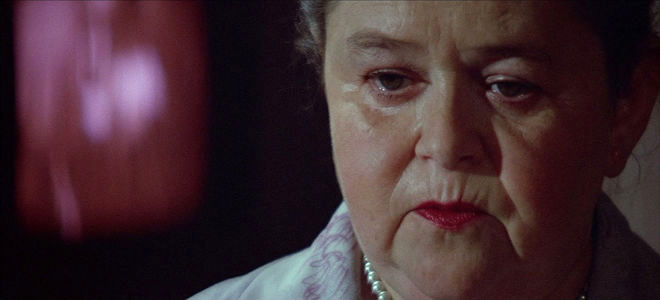
Tangina: "To her, it simply is another child. To us, it is ... the Beast."
Steven: "Beast? You mean like a talking dog?"
Tangina: *Sigh* "Steven, do you ever want to see your daughter again?"
Steven: "In the worst wa- No wait! Best way! BEST Way!"
Steven Spielberg wanted the setting and place of POLTERGEIST to be so much in the now - as if the Freelings could be your next door neighbors and the whacked out stuff that happens is something that could easily happen to you. To do that, he made everything relevant to the lives of his protagonists. From the way people watched TV, to their remote controls, to the problems common with household appliances, right down to teaching your under-age daughter the proper way to handle sexual harassment from the creepy workmen who dig your swimming pool (I don't mean the workmen "dig your swimming pool" as in they think it's really cool. I mean they are physically digging it: Digging a hole; shovels and stuff.).
There are pointed references about clothing, sexual mores, mention of being "punk", and product placement in nearly every scene. As a haunted house movie, POLTERGEIST really spoke to the audience of its era. Today, however, it can only pass as a period piece movie: This is what happened back in the faraway past.
Special kudos must go to Beatrice Straight, as the lonely Professor looking for answers among the dead, and Zelda Rubinstein, who grabbed everyone's attention as the self-assured psychic who knows exactly what to do in the strangest of cases4. Kudos must also go to SFX artist, Gary Platek (RAIDERS OF THE LOST ARK, AMITYVILLE 3D, GHOST BUSTERS, GREMLINS, TOTAL RECALL, JURASSIC PARK), whose wizardry at cloud effects from 25 years ago remains unrivaled by modern cgi today.
In some ways, POLTERGEIST is ripe for a possible remake. In many other ways, we could do better. The addendum ending in particular shoots straight into disbelief land, not so much for the ghosts we see, but the fact that it betrays its own logic from everything we've come to learn of the family. There's just no way they would DO that.
Yet POLTERGEIST set a bar. And there is a huge difference between setting a bar and merely resetting it with a remake. The world is full of good haunted house stories and POLTERGEIST is one of them, but it isn't the only one or even the best one. Still, if you've never seen it, I'd be willing to bet it will raise goosebumps.
Four Shriek Girls.




This review copyright 2006 E.C.McMullen Jr.

|
| DRESS NICE | |
| YOU MIGHT ALSO ENJOY (Sub-Section: HAUNTED PLACES) |
||
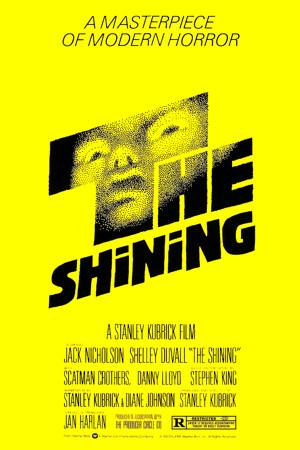 |
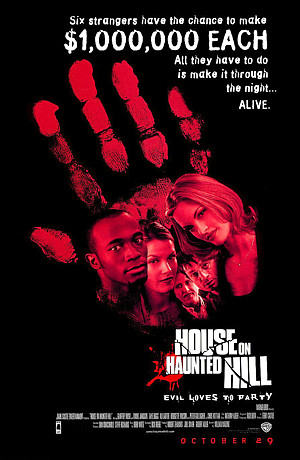 |
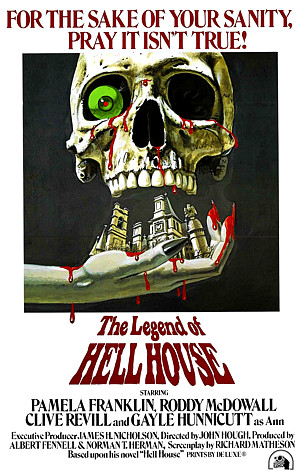 |
| THE SHINING MOVIE REVIEW |
HOUSE ON HAUNTED HILL MOVIE REVIEW |
THE LEGEND OF HELL HOUSE MOVIE REVIEW |
FEO AMANTE'S HORROR THRILLERCreated by:E.C.McMullen Jr. FOLLOW ME @ |
| Amazon |
| ECMJr |
| Feo Blog |
| IMDb |
| Stage32 |
| YouTube |
| Zazzle Shop |
